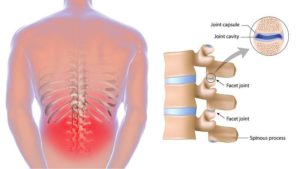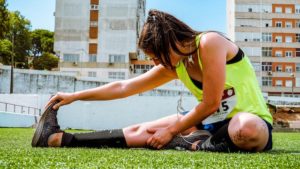You know what is worse than having back pain all the time?
Having shooting pain down your leg that would not let you fall asleep for one good night.
If you agree with that sentence, you must be one of sciatica pain’s victims who were deprived from good night sleep because of the pins and needles in their leg.
For all people with sciatica nerve pain, sciatica pain relief has been a dream for a long time.
But what if you find the solution right now and right here?
 Before telling you how to enjoy a sciatica-pain-free night and get rid of your sciatica pain from the comfort of your home with the help of an Expert Pilates Master or outstanding online yoga teacher in London.
Before telling you how to enjoy a sciatica-pain-free night and get rid of your sciatica pain from the comfort of your home with the help of an Expert Pilates Master or outstanding online yoga teacher in London.
Let’s have a look at what sciatica pain is, how sciatic nerve pain occurs and then progress to the most successful ways of sciatica pain relief.
And if you want to jump straight and learn how you can get rid of your sciatica pain click on these links now to read Franco’s, Hayley, Jan, Elizabeth Tiffany, Michaela and Huw’s back transformation case studies.
Meet the Sciatica Pain
If you are experiencing sciatica pain, then you must be familiar with how terrible and disabling it can get.
The thing is, it is important to know that research shows that the sciatic pain is a large nerve that carries nerve signals to and from your legs.[1]
When this nerve is irritated, pinched or compressed anywhere along its course, pain occurs in form of:
• Shooting pain,
• Pins,
• Needles,
• Tingling,
• Burning sensation through the back of the thigh, leg and
• even sole of the foot. [1]
 The causes of sciatic pain may vary, but the most common cause is a herniated disc in the lumbar area. [1],[2]
The causes of sciatic pain may vary, but the most common cause is a herniated disc in the lumbar area. [1],[2]
If you had done an MRI and did not fund a herniated disc causing your sciatica pain, you might be suffering from a non-discogenic sciatica.
Did you know that uncommon causes of sciatica might be anything from a flat foot to sacroiliac joint dysfunction?
Get assessed by a professional long term back rehab rehab personal trainer to find out where your pain comes from.
REQUEST A FREE CONSULTATION NOW!How to Get Better Sleep with Sciatica Pain
Suffering from sciatica pain should not be a life-long thing.
But, let’s agree to the fact that nerve pain takes time to go away, and improvement will take some time. [2]
But, does this mean you will never have good sleep while you are on your rehabilitation journey.
Eventually there are things you can do to improve your sleep quality and get some nightie-night sleep.
Here are some very valuable tips:
1- Find Your Best Sleeping Position
Disc herniation do not always occur the same way, disc herniations might be:
– Lateral: which means the disc bulges to the side compressing the nerve root as it exits the spinal canal.
– Postero-lateral: which means the disc bulges backward and to the side compromising the space through which nerves exit the spinal canal.
– Posterior: which means the disc bulges backward in the center of the canal which may result in narrowing of the spinal canal itself as well as the foramen (opening) through which the nerve roots exit the spinal canal. [3]
 Because disc bulges are not all the same, for you – there is no way to tell which position leads to peripheralisation (worsening) and which one leads to centralisation (improvement) of the symptoms. [4]
Because disc bulges are not all the same, for you – there is no way to tell which position leads to peripheralisation (worsening) and which one leads to centralisation (improvement) of the symptoms. [4]
Thus, it is a matter of trial and error.
When you assume a position for a couple of minutes, focus with the pain down your leg and find the position that lessens the tingling. [5]
- One or more of the positions you assume will eventually widen the nerve exit and relieve the pressure on your nerve and thus, leading to sciatica pain relief.
You can try different positions especially lying down on your sound side with your uppermost leg bent on a pillow, or both knees bent to a fetal position.
This position can gently stretch your back muscles, loosen your soft tissues and help you get rid of the tension in your muscles. [4],[5]
2- Make Sure That You Support Yourself
Providing support to your body parts while lying down is another way you could help your muscles relax.
There are no rules for where to put your extra pillows.
But, for instance, if you have a space between your back and the bed or your waist and the bed, put an appropriate-in-size pillow to support your back.
Also, placing a pillow between your legs can help you preventing rotation in your hip and puts less tension on your sacroiliac joints which are directly connected to your spine. [6]
3- Sleep On The Floor
Nothing is better than going back to nature!
Lying down on the floor is one of the recommended things to do if you are suffering from sciatica pain.
Lie down on the floor and put your hips and knees in 90-degree angles by putting your legs on a chair. [6]
If you suffer from lots of tightness this position helps restoring the spine curves and relieves the load on your discs.
Make sure you give yourself time to lie down on the floor 15-20 minutes per day to help unload your vertebral discs and relieve at least some of your symptoms.
Although it might be hard to actually “fall asleep” on the floor, it will always help you reduce your symptoms so that you can have better night sleep.
4- Prepare For Your Bedtime
Preparing for bedtime is not only all about going to the washroom and brushing your teeth.
 There are more things you can do to improve your symptoms and have a quality sleep.
There are more things you can do to improve your symptoms and have a quality sleep.
For instance, you can do simple stretching to stretch your muscles and get rid of the stress you had all day.
Or you can dedicate some minutes for the nerve flossing exercise. [7]
Simply lie on your back, plant one foot on the bed and raise your other leg to the knee level, from this position, move your ankle back and forth and feel the stretch in the back of your leg.
These exercises help you improve your muscle and nerve flexibility and can give you a pain-free night.
If you need to implement a very effective sciatic-nerve-friendly programme in your life and make your night sleep calmer and more efficient.
Join Jazz Alessi for his number one sciatic pain rehab programme in London including the right customised nutrition, stretches, Pilates, yoga, meditation and carefully adjusted strength training.
REQUEST A FREE CONSULTATION NOW!5- Reconsider What You Do Through The Day
Things you do through the day also affect how you sleep at night.
Usually, sciatica pain takes a while to go away, but it keeps getting better and better by the passage of time.[8]
In fact, sciatica pain arises from nerve inflammation that subsides as the body works hard to heal. [8]
But what if you keep sabotaging your body’s attempt to heal?
You might think: of course, I would not do that!
But the truth is, you might be unintentionally interrupting your body’s healing process by exhausting yourself during the day.
For example, if you:
– Stand or sit for long time
– Carry and lift heavy objects
– Walking more than you can handle (at this particular stage)
– Bend and twist frequently
– Assume poor posture [9]
Paying attention to what you do during the day can determine how fast you recover and also how good you sleep that night.
Which Positions To Avoid With Sciatica Pain?
There is no single position that all people suffering from sciatica should avoid
Because as I mentioned, sciatica pain can be caused by different issues, including:
– Disc herniation
– Muscle spasm or soft tissue injury
– Spinal canal narrowing
– Nerve entrapment
– Spondylosis
– Postures and hips misalignment
– Flat or pronated feet
– Leg length discrepancy
– Pelvic hypo or hyper mobility
– Sacroiliac joint dysfunction. [10]
Each of these body states and conditions, and even the same condition in two different people, have different positions that may alleviate or aggravate sciatica pain. [10]
There is no one position 100% guaranteed for pain relief for sciatica.
For this reason, as it is important that SAFELY (safe is the keyword here) you follow the trial-and-error concept to find your best sleeping position for pain relief for sciatica.
It is also important to find keep in mind the position which worsens them and avoid it as much as you can.
What is a bad position for sciatica?
Bad positions for sciatica pain are the positions that put more compression on the sciatic nerve and leads to irritation, inflammation and more sciatic nerve pain. [8]
It can be any position depending on the cause of your sciatica pain and the site at which your sciatic pain is being irritated. [10]
The best solution to avoid bad positions is to “listen to your body”.
Your body will let you know when something is wrong, you can feel that:
– The tingling down your leg is increasing
– Your back feels more stiff
– The pins and needles feeling are extending further down your leg
– Your leg goes numb and heavy
 If you are not sure which positions are bad for your sciatica pain, you can always consult a professional Pilates personal trainer or a very effective professional Online Yoga Teacher who is specialised in sciatica pain rehabilitation.
If you are not sure which positions are bad for your sciatica pain, you can always consult a professional Pilates personal trainer or a very effective professional Online Yoga Teacher who is specialised in sciatica pain rehabilitation.
Get in touch and we’ll guide you for the best option for your case.
REQUEST A FREE CONSULTATION NOW!
Consult London’s #1 Sciatica Nerve Specialist – Jazz Alessi
Now that you know that there is no single cause for sciatic nerve pain, you might have guessed that there is no one-programme-fits-all in sciatica rehabilitation.
Believe it or not, one single exercise can improve someone’s symptoms and can worsen another’s…
Even though both might be complaining of the same typical sciatica symptoms!
For example, if you have sciatica pain, your Pilates personal trainer or Online Yoga Teacher will assess your:
– Medical history
– Doctor’s reports and investigations
– Daily personal habits
– Your working behaviours and needs
– Muscle strength and balance between different muscle groups
– Flexibility
– Nerve and soft tissue mobility
Considering all these aspects, your personal trainer might decide that you have muscle imbalance and might start with gentle stretching exercises, positioning, and customised safe strengthening exercises and proper high-protein plant-based diet to restore tissue health.
In a different case scenario, your Pilates personal trainer might see that you have spinal instability and might recommend no stretches at all because it may worsen your condition.
Instead, he may recommend gradual strengthening exercises that will help you better support your spine.
This is basically how Jazz Alessi designs your laser sharp customised rehabilitation programme based on your very own assessment.
 But it is not the only thing…
But it is not the only thing…
Jazz also takes into consideration your health condition; if you are recovering from an injury or a surgery or if you are diagnosed with a chronic problem, a disease like diabetes, arthritis, osteoarthritis – he makes sure that the sciatica rehab programme is safe for you.
In addition, he takes into account your challenges and prioritises your goals.
No matter whether your goal is to compete in the Olympics or to just be able to go to the grocery store on foot, he has got your back with the right sciatica programme.
Who is Jazz Alessi?
Jazz Alessi is an elite rehab personal trainer in London and nutrition expert who customises the up-to-date, evidence-based exercise programmes with the most effective, custom-made nutrition plans.
His highly scientific and 100% natural process help you achieve the healthy lifestyle you have been dreaming of.
He closely looks into your health history, current complains and future goals in collaboration with medical professional and designs you the most effective customised plan to make your health dreams come true.
References
1- T.L, Anbumani & .A, Thamarai & S, Anthony. (2015). Sciatic nerve and its variations: an anatomical study. International Journal of Anatomy and Research. 3. 1121-1127. 10.16965/ijar.2015.175.
https://www.researchgate.net/publication/281318351_Sciatic_nerve_and_its_variations_an_anatomical_study
2- Koes BW, van Tulder MW, Peul WC. Diagnosis and treatment of sciatica. BMJ. 2007 Jun 23;334(7607):1313-7. doi: 10.1136/bmj.39223.428495.BE. PMID: 17585160; PMCID: PMC1895638.
https://www.ncbi.nlm.nih.gov/pmc/articles/PMC1895638/
3- Fardon DF, Milette PC; Combined Task Forces of the North American Spine Society, American Society of Spine Radiology, and American Society of Neuroradiology. Nomenclature and classification of lumbar disc pathology. Recommendations of the Combined task Forces of the North American Spine Society, American Society of Spine Radiology, and American Society of Neuroradiology. Spine (Phila Pa 1976). 2001 Mar 1;26(5):E93-E113. doi: 10.1097/00007632-200103010-00006. PMID: 11242399.
https://pubmed.ncbi.nlm.nih.gov/11242399/
4- Truszczynska-Baszak, Aleksandra & Rapała, Kazimierz & Lukawski, Stanisław. (2006). Correlation between centralization or peripheralization of symptoms in low back pain and the results of magnetic resonance imaging. Ortopedia, traumatologia, rehabilitacja. 8. 531-6.
https://www.researchgate.net/publication/6248862_Correlation_between_centralization_or_peripheralization_of_symptoms_in_low_back_pain_and_the_results_of_magnetic_resonance_imaging
5- Vroomen, Patrick & de Krom, Marc & Slofstra, Patty & Knottnerus, J.. (2001). Conservative Treatment of Sciatica: A Systematic Review. Journal of spinal disorders. 13. 463-9. 10.1097/00002517-200012000-00001.
https://www.researchgate.net/publication/12195928_Conservative_Treatment_of_Sciatica_A_Systematic_Review
6- Help Guide: Sleeping Posture & Positions: Physiomed UK
https://www.physiomed.co.uk/uploads/guide/file/16/Physiomed_Sleeping_Posture_Digital.pdf
7- Coppieters MW, Andersen LS, Johansen R, Giskegjerde PK, Høivik M, Vestre S, Nee RJ. Excursion of the Sciatic Nerve During Nerve Mobilization Exercises: An In Vivo Cross-sectional Study Using Dynamic Ultrasound Imaging. J Orthop Sports Phys Ther. 2015 Oct;45(10):731-7. doi: 10.2519/jospt.2015.5743. Epub 2015 Aug 24. PMID: 26304637.
https://pubmed.ncbi.nlm.nih.gov/26304637/
8- Trager, Robert. (2019). The pathophysiology of sciatica.
https://www.researchgate.net/publication/351351380_The_pathophysiology_of_sciatica
9- Fairag M, Kurdi R, Alkathiry A, Alghamdi N, Alshehri R, Alturkistany FO, Almutairi A, Mansory M, Alhamed M, Alzahrani A, Alhazmi A. Risk Factors, Prevention, and Primary and Secondary Management of Sciatica: An Updated Overview. Cureus. 2022 Nov 12;14(11):e31405. doi: 10.7759/cureus.31405. PMID: 36514653; PMCID: PMC9743914.
https://www.ncbi.nlm.nih.gov/pmc/articles/PMC9743914/
10- Siddiq MAB, Clegg D, Hasan SA, Rasker JJ. Extra-spinal sciatica and sciatica mimics: a scoping review. Korean J Pain. 2020 Oct 1;33(4):305-317. doi: 10.3344/kjp.2020.33.4.305. PMID: 32989195; PMCID: PMC7532296.
https://www.ncbi.nlm.nih.gov/pmc/articles/PMC7532296/



